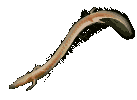| Proteus
anguinus
|
the
`human
fish' |
 
|
Proteus
anguinus,
is
one
of
the
world's
most
unusual
animals.
For
centuries
locals
have
reported
rare
sightings
of
the
`human
fish'
in
springs
of
the
karst
region
(a
limestone
region
of
underground
rivers,
gorges
and
caves)
of
Slovenia's
Primorska
province.
|
It's
a
kind
of
salamander
25
to
30cm
long,
but
it
is
not
related
to
any
other
amphibian
and
is
the
largest
permanent
cave-dwelling
vertebrate
known
to
science.
It
lives
in
the
pitch-black
waters
of
the
karst
region,
and
is
blind
with
atrophied,
almost
invisible
eyes.
It
has
a
long
tail
which
it
uses
for
swimming,
but
can
also
propel
itself
with
its
four
legs.
It
breathes
through
frilly,
bright-red
gills
and
has
primitive
lungs
for
breathing
on
land.
Proteus
anguinus
has
a
powerful
sense
of
smell
and
is
sensitive
to
weak
electrical
fields
in
the
water
which
it
uses
to
navigate,
communicate
and
locate
prey.
The
human-like
skin
has
no
pigment
whatsoever,
but
looks
pink
in
the
light
due
to
the
animal's
blood
circulation.
How
does
it
reproduce?
They
probably
hatch
their
young
from
eggs
and
they
probably
don't
reach
sexual
maturity
until
the
age
of
16
or
18.
But
nobody
really
knows
because,
despite
three
centuries
of
study,
nobody's
ever
seen
it
happen
in
the
wild
and
the
little
critters
aren't
too
cooperative
in
captivity
(one
hasn't
eaten
in
12
years).
Slovenia
Lonely Planet
Home

